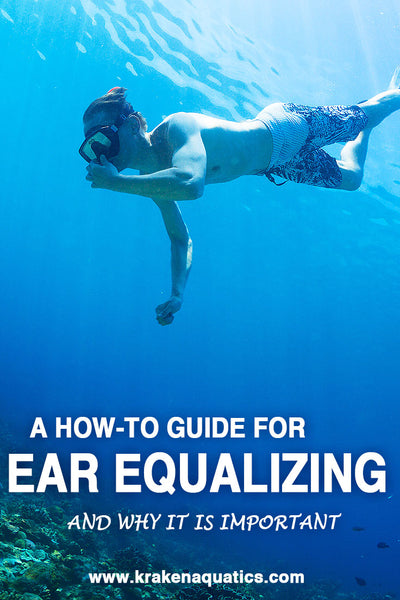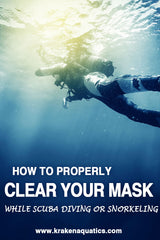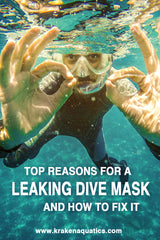
You may not know it, but you’re actually equalizing your ear daily every time you swallow. That pop you’re hearing when swallowing? That’s basically your soft palate muscle pulling your Eustachian tube. To better understand this, let’s go back to the physiology of the ears.
The ear has three structures: the outer ear, the middle ear, and the inner ear. The middle ear, as the name implies, lies between the inner and outer ear. It is filled with dead air spaces and is connected by Eustachian tubes that go through the back of the throat.
When the pressure in your middle ear doesn’t match the pressure from the inner and outer ear, the middle ear will experience pain known as barotrauma. It does sound critical but it is a common injury in the ears. You experience this during airplane flights or deep scuba diving.
Our ears are not designed to quickly adapt to rapid pressure changes. That’s the reason why we experience barotrauma during air flight and deep diving. The good news is, there is something we can do to kick off this pressure pain – by equalizing.
Again, we experience barotrauma when the pressure in the middle ear is not equal to the pressure in the outer and inner ear. Hence, we need to ‘equalize’ the pressure. By equalizing, we force the Eustachian tubes to open. The Eustachian tubes are normally closed to prevent contaminants in the nose to enter the middle ears. We need to open the tubes to allow high-pressure air from the throat to move into the middle ears. You can do that by swallowing. Yeah, as simple as that.
Just as I said in the very beginning, you’ve been equalizing your ears – unconsciously – the entire time. However, in scuba diving, you need to equalize your ears consciously and mindfully. Unlike simple swallowing, there are special methods you need to perform to equalize your ears.
-
Valsalva Maneuver
Valsalva Maneuver is one of the effective ways to equalize your blocked ears. Have you ever wondered why many divers suggest pinching your nostrils as you delve into the water? That’s because there is a good reason for doing that. Pinching your nostrils and exhaling through it allows high pressure to pass in the Eustachian tube. However, this method is not always safe. Because you are encouraged to blow hard through your nose, you might overdo it and cause more injuries to your ears. Also, when your nose is blocked and you blow air out too hard, it can only cause internal fluid pressure that can rupture the round windows of your ears. So remember, don’t blow too hard. -
Toynbee Maneuver
In this method, all you have to do is to pinch your nose then swallow. When you swallow, you’re pulling the Eustachian tubes open. And the movement of your tongue with your nostrils blocked compresses air against the Eustachian tube. Thus, equalizes your ear. -
Lowry Technique
This is Valsalva maneuver and Toynbee maneuver joined together. Pinch your nose, blow, then swallow. -
Frenzel Maneuver
You’ll love this one – or maybe not? – In this method, you need to pinch your nose to block air, then with your mouth closed and throat constricted (as if you’re lifting a 250-pound dumbbell). Next is to make the K sound. This will force your tongue to pull upward and compress air off of the openings of the Eustachian tubes. -
Voluntary Tubal Opening
This one’s a bit tricky, and boy, it needs a lot of practice. Many divers – professional ones – love this technique because it allows them to have a continuous equalization. To perform this equalization, you need to tense your throat and your soft palate as you push your jaw forward and down like you’re about to yawn. The muscles will pull the Eustachian tubes to open. -
Edmonds Technique
This is sort of a combination of Salvalsa Maneuver and Voluntary Tubal Opening. You need to tense your soft palate and throat muscles (again, as if you are lifting weight), then push your jaw forward and down. Then, pinch your nose and blow. This is easier to say than to do, so we encourage you to practice this in a shallow pool with a professional.
These methods – primarily, swallowing – are effective ways to open the closed Eustachian tubes. These tricks can reduce the pressure in the middle ear to match the pressure in the outer and inner ear. Tensing and utilizing the throat muscles are the safest way to equalize as they open the tubes.
Watch our video Avoid Pain While Diving By Equalizing Your Ears to watch an example of how ear equalizing is done. Also, be sure to subscribe to our YouTube channel for more videos like this.
Wait, why are we discussing these things anyway?
 It’s because you need to learn how to equalize simply because there will always be a point in your diving moments that you need to perform any of the methods mentioned to equalize your ears.
It’s because you need to learn how to equalize simply because there will always be a point in your diving moments that you need to perform any of the methods mentioned to equalize your ears.
If you don’t equalize often, the pressure from outer ear and inner ear will force the ends of the Eustachian tubes to close and compromise the soft tissues in it. When there is air in these soft tissues that force them, it shuts down. That means no air can get into the middle ears and can cause barotrauma.
Here are some tips to help you equalize more efficiently:
-
Equalize your ears before starting
Yes, you must act early. Before diving, gently equalize your ears. -
Feet first
As you descend deep down the water, it’s always helpful if you have your feet first. Some studies show that it’s easier to perform Valsalva Maneuver when in a head-up position. -
Tilt your head up
When you extend your neck, your Eustachian tube tends to open. -
Equalize often
Clear the blockage in your ears often to maintain a positive pressure in your middle ears. You don’t have to wait for the pain before you have to equalize! -
Does it really hurt? Then stop!
If you start to feel pain during your decent, stop descending and a scend a few feet and try equalizing again. If the pain persists and you are unable to equalize, stop. Ascend and go to the surface. The pain may be because the Eustachian tubes are locked shut by the pressure differential. Go to the surface and equalize again. -
Drink lots of H2O
Keep yourself hydrated. Drink a lot of water. When you’re dehydrated, the mucus tends to become thicker. Thick mucus is more likely to block your nasal and Eustachian tubes.
Let’s talk about nasal congestion
One of the things that can cause a diver difficulty in clearing the ears is nasal congestion. That’s when there is mucus blocking the sinus openings and the Eustachian tubes. Nasal congestion can be treated by using medicines like antihistamine and decongestants. However, some medicines have side effects that may affect the cardiovascular system like increased heart rate. This adverse effect can negatively impact your diving experience and perhaps can make things just worst.
So here are some tips to avoid nasal congestion:
-
Avoid milk
Yeah. Just avoid milk. Milk can increase the mucus production. And if you’re an intrepid diver, the mucus, that slimy thing that blocks your sinus, is a big no-no! So again. Avoid. Milk. -
Tobacco and alcohol
Tobacco and alcohol can trigger the mucous membranes to produce mucus. And again, we don’t want the mucus to block the Eustachian tubes.
What’s reverse block?
When you ascend, the water pressure normally decreases and lets some air pressure get out of the Eustachian tube. Hence, clearing the ears is a natural thing the body does. But, what if you’re congested or you have inflamed Eustachian tube? There’s a chance a reverse block would happen. It’s when there is too much air pressure in the middle ear to the point your eardrum would be bent outwards. This will result in pain in the ears. Performing a Valsalva Maneuver at this point in time is a big NO as it can only make things worse (which we will discuss further later on). To fix the problem, descend a few feet and release air pressure by wiggling your jaw. You can also perform Toynbee Maneuver. Doing so creates negative pressure and help suck the air pressure out of the middle ear.
Here’s what you need to know about Valsalva Maneuver
As of the moment, you learned that Valsalva Maneuver is the most common ear-clearing technique many divers perform. It can be performed by simply pinching your nose and blowing air out at the same time.
Do you remember what the safest way to clear your ears is? Yes. By utilizing and tensing the muscles of the throat. Unfortunately, Valsalva Maneuver doesn’t do this. It doesn’t activate the throat muscles. Instead, it only pushes air out from the throat to the Eustachian tubes. And if you perform this method when you’re already experiencing pain in the ears, it can only add up pressure in the already pressure-filled middle ear. So yeah, unless you want to rupture the round and oval windows of your inner ear, then don’t perform this clearing technique – or other similar techniques – when experiencing barotrauma. You can perform alternative ear clearing methods like wiggling your jaw or performing the Toynbee Maneuver.




